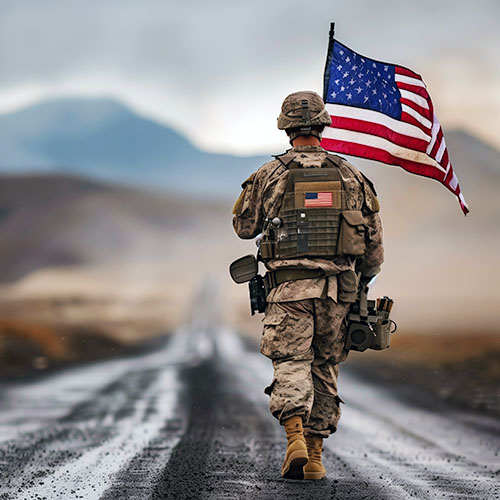January 6, 2021 — a new day of infamy. Military servicemembers and veterans of the post-9/11 wars played pivotal roles across the Capitol — on all sides of the clash. Our national security columnist asks: How did we get here?
The Shadow of the Forever Wars
The war’s come home. That was the thought that kept racing through my head as I, like most every other American citizen with access to a television, watched the surreal events of Jan. 6 unfold in real time.
The backdrop of the U.S. Capitol under a gray January sky felt off. But some of the other images and video seemed more familiar, like something out of a history book. The angry mob on the steps of the Capitol facing off against undermanned and underequipped police, for one. The howling, pervasive rage of the protestors, for another, so certain in the rightness of their cause. The following days would provide even more resonant imagery: National Guardsmen napping while they could in the halls and rotundas of the building, members of Congress and the Senate forced to go through metal detectors, a labyrinth of metal fences and concertina wire surrounding it all.
The Forever War’s come home.
From my vantage point, any protestor became an insurrectionist the minute they breached the Capitol, illegally trespassing upon federal property and sullying the American citadel of democracy itself. (What American law says about that distinction will take some time, of course.) One of those insurrectionists was Larry Brock, a retired Air Force lieutenant colonel photographed in the well of the Senate, wearing body armor and a tactical helmet like he was on patrol in Kabul. Another was retired Navy SEAL Adam Newbold, who filmed a viral video about the thrills of the day, while driving back home to Ohio, only to express regret over what happened after the media identified him and the FBI contacted him. An active-duty Army captain stationed at Fort Bragg has also been identified and is being investigated for her alleged role in the storming of the Capitol.
And the woman who was shot and killed while entering a secure hallway in the Capitol was also a veteran. Ashli Babbitt served in the Air Force for 14 years, which included deployments to Iraq and Afghanistan. Squaring her reported fringe, conspiracy-laden views — let alone her actions in the Capitol — with her honorable service is not easy, but it’s where we’re at in 2021.
More, perhaps many more, servicemembers and vets will receive public scrutiny for entering the Capitol on Jan. 6. Consequences await. If convicted of wrongdoing, Brock could well lose his pension, as one example, due to a federal law known as the Hiss Act. As retired Army officer turned civilian-military political scholar Jim Golby tweeted the following week: “The vast majority of veterans are not extremists, but there are a large number of veterans among extremist groups.”
Then there’s the other side of Jan. 6, also duly represented by Those Who Have Borne the Battle. Heroic policeman Eugene Goodman, who baited the initial breachers into following him upstairs and away from the main Senate entrance? An Army veteran of the 101st Airborne Division and the Iraq war. Slain Capitol Police Officer Brian Sicknick was also an Iraq veteran, having deployed to the region with the Air National Guard as part of Operation Desert Shield in the early ’90s. Other Americans killed him while he was on duty, and he will be buried at Arlington National Cemetery.
Inside the building’s chambers were combat veterans, too. Like Congressman Ruben Gallego of Arizona — another veteran of Iraq, with the Marines — who helped evacuating colleagues put on their gas masks. And Congressman Jason Crow of Colorado — of the Army’s 82nd Airborne and 75th Ranger Regiment, in Iraq and Afghanistan — who comforted terrified, and temporarily trapped, colleagues and was the last legislator to leave the floor. Both men displayed leadership in the unforgiving minute, like the ole Kipling poem “If — ” goes. Both also later likened what happened to combat, and how their brains and bodies simply flipped a switch to their former selves.
There were more, certainly, on all the various sides, with connections to the forever wars of their recent pasts, some using them as justification for their actions in the present. There were still others, like the many hundreds of thousands in the crowd at the Ellipse park who remained there, believing, then and after, they’d been part of a peaceful, patriotic display sullied by bad actors and chaos agents.
On the day after Jan. 6, I talked on the phone to one of these men and his wife, supporters of Donald Trump and also of their constitutional right to peaceably assemble. We served together in Iraq. He’s a patriot and like a brother to me. John Wayne has nothing on this man in terms of understanding duty and exemplifying service. He and his wife had a powerful experience the morning of Jan. 6 at the rally. That happened. It was real, and it matters.
Then everything else happened, and he rightly suspects what came after will be what the history books remember. Is that fair? No. And also yes. Hell if I know. I wasn’t there. But my brother, my sibling, was. Locked down on the first floor of the Capitol, in a safe room with his colleagues, some of whom were weeping. Others were praying. My brother told jokes because that’s who he is — he wanted to calm the others as best he could. My family and I couldn’t get ahold of him for hours. We were terrified. He’s not a politician; he’s a person who simply went to work that morning. This is the text he sent me that night, when he finally got home: “Hearing the Capitol police officers getting their asses kicked and asking for help and not being able to do anything is all I can think about right now.”
He’s still thinking about it. A lot. He’s a good human. So is my friend who attended the rally. This country needs all the good humans it can get right now.
The forever wars were fuel for some there that day, a reflexive memory for others. Iraq, Afghanistan, Syria and beyond — a multitude of understandings and takeaways were all there on Jan. 6, swirling, clashing, shadows and ghosts driving violent force in some, peace-making in others. That’s the thing with war, of course: No two experiences are ever the same, even when — maybe especially when — they’re from folks who were there together. If I’ve learned nothing from writing about it — whether my own journey or those of others — it’s that. Subjective reality is the prism we all operate life through.
But nations, and our American republic in particular, need objective truth to sustain and thrive.
People died on Jan. 6. Lives were permanently scarred from Jan. 6. Folks who just attended the peaceful part of Jan. 6 have now sent their families into hiding, and some are having their restaurants boycotted. It’s going to take many months, if not longer, to sort through exactly what happened that day and why. Maybe this was a coordinated effort and plot, like some early reportage suggests. Maybe not. Maybe it really is as simple as things getting way out of hand. I want more than anything for it be a one-off or the end of something, but I know deep in my skinny Irish bones it’s anything but. It’s a new beginning. A dark one, at that.
In a small Brooklyn apartment on the night of Jan. 6, after I heard from my brother, I didn’t know what do but crack a few beers. I watched some more TV, then turned it off, which is often the wise choice for us all. I sat in the dark and listened to the sleeping sounds of my two young boys. They deserve to grow up believing in their country, loving their country, as I knew it and know it still: the United States of America. United being the key word. I put on a song, a classic, one I used to listen to with my brother as boys before we went outside to play solider: “The Battle Cry of Freedom” with its ultimate refrain: The Union forever.
Beyond providing this look into Forever Wars, Matt Gallagher is a U.S. Army veteran and the author of three books, including the novel Empire City.



















